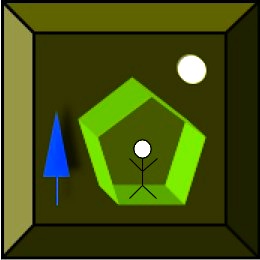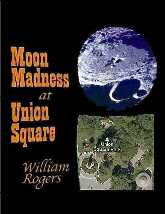Fiction Stories by William Rogers
Moon Madness at Union Square 
Twenty three year-old Samantha Rolland wants to book a vacation package on the Moon. Of course, there are no such things at present.
She worries that society and NASA have lost courage and commitment at spending money and taking risks for space exploration and space development. Samantha has a very simple public relations idea about how to speed up the process. Her boyfriend Tyler has signed on to help, as has a retired professor. Her recently-divorced and remarried mother may even make a considerable donation for Samantha's public relations project.
But is society ready? There are those who believe the Moon should remain pristinely untouched. There are others who favor industrial development, but obviously not for vacationers. There are those who believe only government certified astronauts should go to the Moon. And, there are those who are mentally unbalanced, whose reactions to her campaign are unpredictable. Will any of these groups try to stop Samantha at any cost should her promotional project get off the ground?
Already a pair of well-financed critics at Union Square Park has been secretly snapping pictures of Samantha and Tyler and then retreating to the nearby Chelsea Hotel on West 23rd Street to cook up anonymous press releases to make her seem like a lunatic.
CHAPTER 1
Union Square Park in Manhattan marks the junction at 14th Street of several important main thoroughfares, which is how it got its name. The three-block by two-block park near Broadway is mostly unfenced, encouraging idlers, peddlers, tourists, and local residents to stroll in from any angle to escape the city's busy life. The park also has a colorful history. Over the last century and a half, it's been the scene of draft riots, political movements, and counter-culture campaigns. So natually, the neighborhood has been a place for people to promote new, crazy, reactionary, or even revolutionary ideas.
It’s a warm Monday afternoon in September. Manhattanites Samantha Rolland and Tyler Nardivant are standing at the corner of Union Square East and 15th Street. Tyler, who is 21, is drinking from a can of orange soda through a straw. Samantha, who is 23, is leaning against a railing attached to what once was Union Square Savings Bank, and before that the Institution for the Savings of Merchant’s Clerks. The bank-turned-theatre with its large pillars looks like one of the public buildings of Ancient Rome.
“Right now,” Samantha opines, “these people passing by don’t care a hoot about the possibilities the Moon offers.”
Tyler looks several shoppers up and down who are just passing. “So, what are you going to do about it?”
“I don’t know;" she explains, "but when I was in college one of my professors predicted that people our age would eventually have the chance to buy a ticket at a travel agency for a vacation trip to the Moon. At the time, I believed him. But now I don’t think it will happen before I die.”
Tyler walks over to a trash basket and tosses his now empty soda can. Just then, a small fluffy white dog on a leash starts barking pointedly at Tyler for no apparent reason. Maybe it’s that silly 5¢ soda can and bottle deposit so few people worry about redeeming anymore.
Tyler has an idea. “Sam, you need to start a publicity campaign.”
“How do I do that,” she asks.
“You need to do something or say something that will capture people’s imagination. Then maybe the media will pay attention.”
“You mean invent a slogan like, ‘Rocket to the Moon and back, the ultimate amusement event!’”
“Well you’ll have to work on that one.”
A moment goes by while the still-unemployed Columbia University graduate living on a modest trust fund thinks about the problem.
Then she proposes an idea. “Maybe I could get sponsors to propose projects they’d like to erect on the Moon. You know something like the Moonbeam Hilton, Belleview Hospital Lunar Extension, PGA Training Station, Columbia University College of Natural Satellite Studies, Green Cheese Institute, Man in the Moon Club, and Moonshine Liquors.”
“That’s not what I meant," answers Tyler with a look of mock horror.
Tyler, the A-student who currently majors in Media Communication at New York University continues:
"But maybe you can do a Moon art contest that shows what a vacation village on the Moon would look like. You know, drawings that show how the Moon's low gravity and absence of an atmosphere would allow lunar designers to erect exotic looking buildings.”
Just then, some younger people arrive at the building that used to be a bank, but is now a theatre. They are after tickets for some production that no one admits to understanding but everyone is willing to pay the price of a Broadway theatre ticket to see. It’s a visual extravaganza. Its only message may be, “If something looks good, sounds good, feels good and smells good, it must be good, especially if your parents don’t seem interested in it.”
“That’s the problem,” Samantha observes, “No one needs reality to get excited about anymore. Escapist entertainment will do just fine”
Tyler looks over the new arrivals and whispers to Samantha, “Tourists! I bet they think the first person to walk on the Moon was Buzz Lightyear.”
“Who on earth is Buzz Lightyear?”
“A cartoon character. But according to a survey, there are people in the world who think the cartoon character made the Apollo 11 trip. Of course there are the conspiracy groups who think the whole Moon-landing thing was a hoax.”
Samantha looks over the crowd passing by and asks, “Why would people think that?” Then she answers her own question. “Of course, believing it a hoax makes them feel vindicated and superior.”
Tyler then plays devil’s advocate. “But, you feel good believing that they actually went to the Moon in 1969.”
“Yes, but for it to be a hoax, thousands of people would have had to tell the same lies over and over for more than forty years. Then there is the videotape. You couldn’t Photoshop images back then. And there was more than one expedition.”
“Well,” Tyler concedes, “You couldn’t make up some of what happened. For example, there was a funny conversation when Apollo 11 was about to land on the Moon. The guy speaking from Houston asked the astronauts to watch for a lovely girl with a big rabbit.”
“Why?” asks Samantha.
“Apparently an ancient legend says a beautiful Chinese girl called Chang-o has been living on the Moon for 4000 years. It seems she was banished to the Moon because she stole the pill for immortality from her husband. The astronauts were also asked to look for her companion, a large Chinese rabbit, who is easy to spot since he is only standing on his hind feet in the shade of a cinnamon tree.”
“A cinnamon tree on the Moon?”
Tyler nods and adds, “I’m taking a class on media communication. If what you’re saying is true about the people who believe in the Moon landing hoax, then they may been fed a lot of propaganda.”
“Maybe that’s what I need to get people interested in development of the Moon, Tyler, propaganda. But, how do you make propaganda?”
Tyler nods his head. “There are three basic kinds. The most intense is where you make up horrible lies about people or situations. In the middle, you stack the deck favoring one side over the other side on some issue. The lightest is where you speak about something in very favorable ways, using exaggeration.”
“Which would I use?” asks Samantha.
“Forget the intense stuff, that would make you out like a lunatic. Pun intended. You would be better stacking the deck or using the light approach.”
“You mean by the light approach I would make pro Moon-development advertisements.”
“Yes.”
“But, how would I use the stack the deck approach.”
“Well, one way would be to compare how bad it is leaving the exploration and development solely to NASA and the government. Then you contrast that with how much better the private sector would be at developing the Moon.”
“So, Tyler, you think the Hilton hotel chain would be better at getting a hotel built on the Moon than NASA.”
“Exactly. And another deck-stacking tactic would be to contrast getting your thrills from reality versus getting them from escapist entertainment.”
“Does your class use a textbook?”
“Yes.”
“Can I borrow it for a couple of days?”
“Sure borrow it for as long as you like, I’ll be able to ace this class without reading the textbook. The professor explains the stuff in the book pretty clearly.”
“I’ll give it back in time for you to sell it back to the bookstore.”
Tyler continues. “Right now, Samantha, you’ve got to use communication to get the drawing contest for the Moon-facilities going. You’ll need money and a way to promote interest in the contest.”
“Yes, I’ll need something spectacular.”
It’s getting late so the two begin walking in opposite directions to get home. Tyler lives in a large apartment complex on the Eastside with his parents. Samantha lives with her thirty-one year old aunt, who tends bar at an upscale club called Le Chat Orange (The Orange Cat). Their shared digs are on Greenwich Street, just below Little West 12th Street in the West Village.
...
LENGTH 76,500 WORDS


